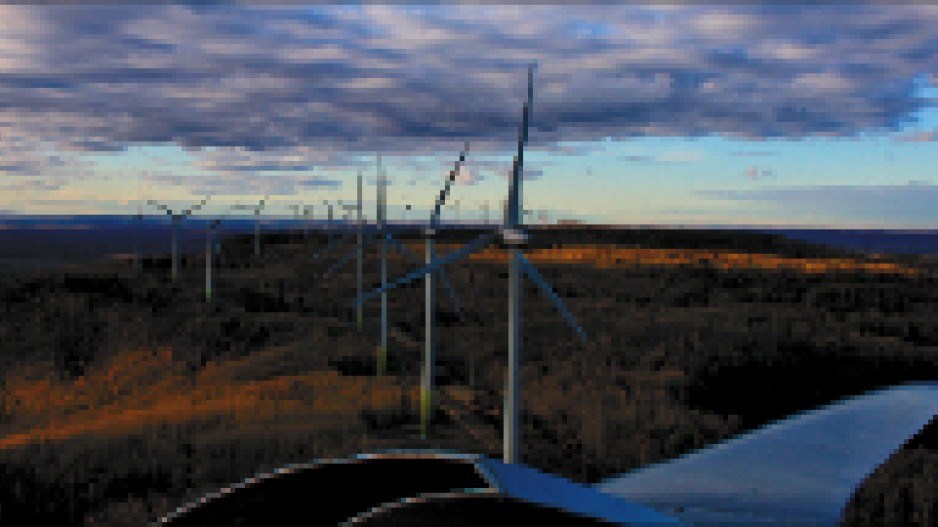Power industry insiders calculate B.C. will need the equivalent of three Site C-sized hydroelectric dams to power northern B.C.’s industrial boom.
While the renewable-energy sector expects to cash in on that boom, some within the sector fear the B.C government will allow natural gas-fired thermal power to generate electricity that wind could provide.
Three liquid natural gas plants and eight new mines are expected to be built in northern B.C. over the next decade. The electrification of northeastern B.C.’s natural gas fields will also require huge amounts of electricity.
“With just the Shell plant being built in Kitimat, Site C is gone, and we’re going to be short,” said Run of River Power CEO Rick Hopp. “What are we going to replace it with?”
BC Hydro’s most recent load forecast projected an additional requirement of 2,900 gigawatt hours (GWh) for the oil and gas and 2,425 GWh for the mining sectors by 2031. One gigawatt hour is a billion watt hours; 2,900 GwH would power approximately 270,000 homes per year.
Those estimates were made before the B.C. government announced its new jobs strategy, which is expected to accelerate new mine and LNG plant construction. BC Hydro was unable to provide updated estimates for industrial demand.
The Canadian Wind Energy Association (CanWEA) commissioned its own forecasts and calculates the new demand at 17,000 GWh.
Hopp estimates the additional power capacity that will be needed to be 3,000 MW.
Site C dam, which has an estimated $8 billion pricetag, will have a capacity of 1,100 MW (enough to power 450,000 homes). That would leave a potential shortfall of 2,000 MW.
That could be good news for renewable energy companies in B.C. But the industry that stands to benefit most – wind power – fears the provincial government will allow much of the new electricity to be generated by burning the gas the industry wants to sell abroad at a higher price, when all the new power could be generated with renewables.
BC Energy and Mines Minister Rich Coleman told Business in Vancouver there is enough capacity within BC Hydro’s system to provide power for the first two new LNG plants, although he said a powerline from Prince George to Kitimat will have to be upgraded.
“With renewables, and shaping it with something like natural gas, we can handle this quite easily,” he said.
Shell plans to build a third LNG plant. Coleman said there are good opportunities for wind, run-of-river and bioenergy from burning forest biomass, but he added that some of the power will have to come from natural gas because wind is intermittent.
“None of these things are firm, so you’re going to have to firm it up,” Coleman said.
Hopp agreed: “There’s so much demand coming up there, if it all comes together, renewables will not be able to supply anywhere near what this requires.”
But Nicholas Heap, CanWEA’s B.C. regional director, disagreed. He said burning natural gas at North American prices (approximately $2.60 per one million British Thermal Units [mmbtu]) so it can be liquefied and sold at world prices ($14 per mmbtu) makes poor economic sense and would make it difficult for B.C. to meet its greenhouse gas reduction targets.
“You save money for the next three years and you’re paying more for the next 32 or more,” Heap said. “You do that at the cost of the province’s climate leadership.”
It might be cheaper in the short term to build natural gas generators, but gas prices are expected to rise eventually. Heap said wind power is not nearly as expensive to build as it was just a few years ago because the cost of wind turbines has dropped dramatically, and, once built, it becomes a heritage power source like hydro.
He added that wind complements hydro power because winter winds provide peak power when dam water levels are at their lowest. However, wind turbines have to be plugged into the grid if the two power sources are to complement each other.
The Peace region, home to B.C.’s natural gas fields, has vast potential for wind power, but virtually no transmission infrastructure, which is why the B.C. government plans to allow the gas fields to be electrified with natural gas and use carbon sequestering to store excess emissions. •




